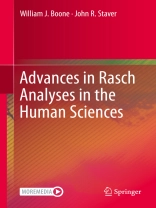This volume follows the publication of Rasch Analysis in the Human Sciences. This new book presents additional topics not discussed in the previous volume. It examines key topics such as partial credit analysis of data, common person linking, computing equating constants, investigating discrimination, evaluating dimensionality, how to better utilize Wright Maps, how to design tests and surveys using Rasch theory, and many more. The book includes activities which can be used to practice the theme of each chapter and to test the reader’s understanding of Rasch techniques. Beginning and ending with a conversation between two students, each chapter provides clear step-by-step instructions as to how to conduct an analysis using the chapter theme. The chapters emphasize applications for the beginner learning Rasch and provide guidance for composing a write-up of an analysis for a presentation, paper, thesis or report.
This book explores in detail many importantyet often rarely discussed topics in Rasch. With its easy-to-read language and engaging format it reaches a wide audience of scientists, clinicians, students, researchers and psychometricians, providing a valuable toolkit for practical users of Rasch analysis. – Dr. Eva Fenwick, Clinical Research Fellow, Singapore Eye Research Institute (SERI) Assistant Professor, Duke-NUS Medical School, Singapore
It is an easy to read book and provides immediate guidance for those wishing to conduct a Rasch analysis. The “conversations” between students in each chapter provides a welcome introduction to each topic. – Prof. Maik Walpuski, University Duisburg-Essen, Germany
The lessons learned in their first book are extended by providing insightful demonstrations of some of the more complex concepts and techniques used in applying Rasch models. – Dr. Michael R. Peabody, National Association of Boards of Pharmacy, Illinois, USA
I am amazed with the ability of these authors to communicate complicated knowledge, and the ability to make this highly complicated knowledge accessible to new learners guiding every step of the way. Through this book we get important knowledge about techniques and the different areas of use for Rasch methods in the human sciences This is truly an important book for students and researchers. – Prof. Charlotte Ringsmose, Aalborg University, Denmark
สารบัญ
Chapter 1. Introduction — For the Second Time.- Chapter 2. Principal Component Analysis of Residuals (PCAR).- Chapter 3. Point Measure Correlation.- Chapter 4. Test Information Function (TIF).- Chapter 5. Disattenuated Correlation.- Chapter 6. Understanding and Utilizing Item Characteristic Curves (ICC) to Further Evaluate the Functioning of a Scale.- Chapter 7. How Well Are Your Instrument Items Helping You to Discriminate and Communicate?.- Chapter 8. Partial Credit Part 1.- Chapter 9. Partial Credit Part II (How to Anchor a Partial Credit Test).- Chapter 10. The Hills…with the Partial Credit Model.- Chapter 11. Common Person Test Equating.- Chapter 12. Virtual Equating of Test Forms.- Chapter 13. Computing and Utilizing an Equating Constant to Explore Items for Linking a Test to an Item Bank.- Chapter 14. Rasch Measurement Estimation Procedures.- Chapter 15. The Importance of Cross Plots for Your Rasch Analysis.- Chapter 16. Wright Maps (Part 3 and counting…).- Chapter 17. Raschand Forms of Validity Evidence.- Chapter 18. Using Rasch Theory to Develop a Test and a Survey.- Chapter 19. Presentation and Explanation Techniques to Use in Rasch Articles.- Chapter 20. Some Concluding Thoughts.
เกี่ยวกับผู้แต่ง
Professor William Boone is faculty member in the department of Educational Psychology at Miami University. He earned a Ph.D. from the University of Chicago’s Department of Education Program in Measurement, Evaluation and Statistical Analysis. His thesis advisor was Benjamin Wright. Dr. Boone lectures and provides workshops concerning Rasch measurement throughout the world. He is the lead author of the book Rasch Analysis in the Human Sciences and he is an author of over 100 articles/reports. His professional goal is to increase the use of Rasch techniques in social science research, market research, and medical research.
Professor John Staver is an Professor Emeritus of Science Education at Purdue University where he co-directed the Center for Research and Engagement in Science and Mathematics Education. Dr. Staver earned an Ed.D. in Science Education from Indiana University-Bloomington. His research interests have focused on constructivist epistemology and its implications for improving science teaching and learning.












